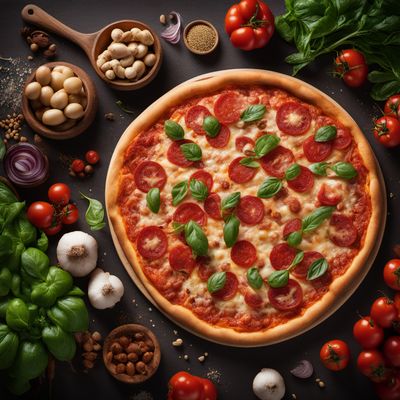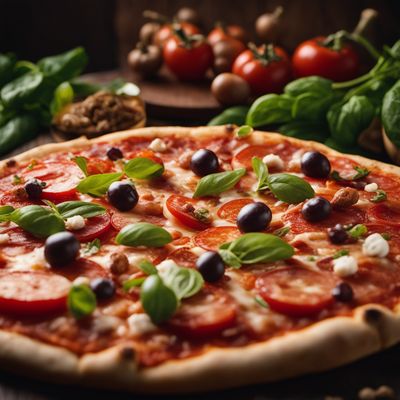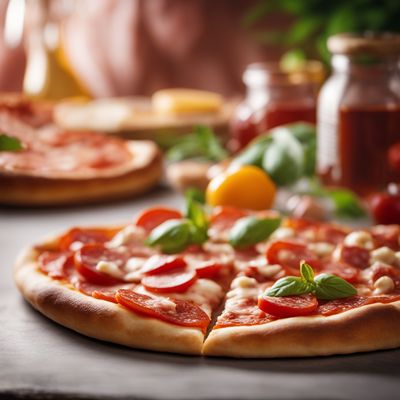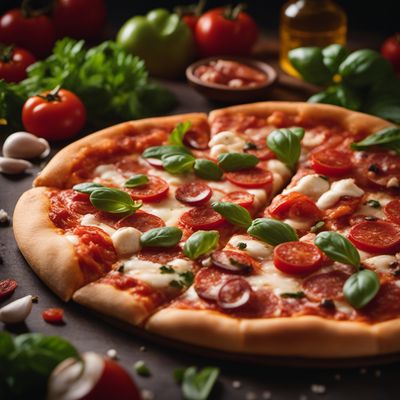
Ingredient
Pizza and pizza-like dishes
The Irresistible World of Savory Delights: Exploring Pizza and its Variations
Pizza is a savory dish that typically consists of a round, flatbread base topped with tomato sauce, cheese, and various toppings. The base is traditionally made with yeast-leavened dough, resulting in a chewy yet crispy texture. The tomato sauce adds a tangy and slightly sweet flavor, while the cheese provides a creamy and melty element. Toppings can range from classic options like pepperoni and mushrooms to more adventurous choices like arugula or truffle oil. The combination of these elements creates a harmonious balance of flavors and textures that make pizza a beloved dish across cultures.
Origins and history
Pizza originated in Naples, Italy, in the late 18th century. It was initially a simple dish made by topping flatbread with tomatoes, garlic, oil, and cheese. Over time, pizza gained popularity among the working class in Naples and eventually spread throughout Italy. In the late 19th and early 20th centuries, Italian immigrants brought pizza to the United States, where it underwent further evolution and became a staple of American cuisine. Today, pizza has countless regional variations and has become a global favorite.
Nutritional information
Pizza can vary widely in its nutritional content depending on the toppings and crust used. On average, a slice of cheese pizza (approximately 1/8th of a 14-inch pizza) contains around 285 calories, 12 grams of fat, 32 grams of carbohydrates, and 12 grams of protein. However, these values can significantly change based on the specific ingredients used.
Allergens
Pizza commonly contains allergens such as wheat (in the crust), dairy (in the cheese), and various toppings like nuts, shellfish, or soy-based products. It is important to check the ingredients and inform individuals with specific allergies or dietary restrictions.
How to select
When selecting a pizza from a pizzeria or restaurant, look for a crust that is golden brown and slightly crispy on the outside, yet soft and chewy on the inside. The cheese should be melted and bubbly, and the toppings should be fresh and evenly distributed. If purchasing frozen pizza, check the expiration date and ensure that the packaging is intact.
Storage recommendations
Leftover pizza should be stored in an airtight container in the refrigerator. It can be reheated in a preheated oven or toaster oven to maintain its crispness. For longer-term storage, pizza can be frozen, individually wrapped in plastic wrap or aluminum foil, and stored in a freezer bag for up to 3 months.
How to produce
Amateur pizza enthusiasts can produce their own pizzas by making homemade dough using a combination of flour, yeast, water, salt, and olive oil. After allowing the dough to rise, it can be rolled out, topped with sauce, cheese, and desired toppings, and baked in a preheated oven until golden and bubbly.
Preparation tips
To achieve a crispy crust, preheat the oven and place the pizza directly on a preheated pizza stone or baking sheet. For a softer crust, brush the edges with olive oil before baking. Experiment with different toppings and combinations to create unique flavor profiles. To prevent a soggy crust, avoid overloading the pizza with too many wet ingredients.
Culinary uses
Pizza is commonly enjoyed as a main course, but it can also be served as an appetizer, snack, or party food. It is a versatile dish that can be customized with a wide range of toppings, making it suitable for various dietary preferences and restrictions.
Availability
Pizza is widely available in pizzerias, restaurants, and fast-food chains around the world. It is also a popular frozen food option in supermarkets and grocery stores.
More ingredients from this category

Pizza and similar with vegetable topping
Veggie Delight

Pizza and similar with cheese, and vegetables and fruits
The Perfect Medley: Unveiling the Harmonious Blend of Cheese, Vegetables, and Fruits in Pizza and Similar Creations

Pizza and similar with cheese, meat, and mushrooms
Savory Delights: Exploring the World of Cheesy, Meaty, and Mushroomy Pizzas

Pizza and similar with cheese, meat, and vegetables
Savory Delights: Exploring the World of Pizza

Pizza and similar with cheese, and mushrooms
The Perfect Combination: Cheese and Mushrooms on a Pizza

Pizza and similar with cheese topping
Cheesy Delights: Pizza and More

Pizza and similar with fish/seafood topping
Oceanic Delights

Pizza and similar with processed meat topping
Savory Delights: Exploring the World of Meat-Topped Pizzas

Pizza and similar with cheese, and vegetables
The Classic Combination of Cheese and Vegetables

Pizza and similar with cheese, meat, mushrooms, and vegetables
Savory Medley: Exploring the World of Pizza and its Tantalizing Toppings

Pizza and similar with meat, and vegetables
Savory Delights: Exploring the World of Meat and Vegetable Pizzas